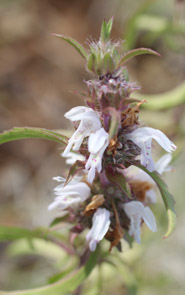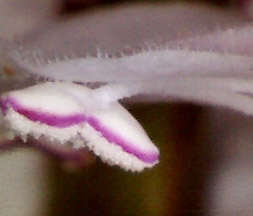 |
 |
|
The anther |
Ethnobotanical Uses
Food:
"As a spice, obviously. The flowers are rather hot and make a nice addition to salsa or chili dishes. The leaves can be use interchangeably with Mexican or Greek oregano." (Moore 116)
"Wild bergamot plants have been cooked alone as a potherb or used (like oregano) to flavor meat dishes, soups and stews. They can also make delicious, fragrant teas. ---Native peoples sprinkled the dried leaves on meat and drying berries to repel insects." (Kershaw 156)
"Like a lot of other folks people from most of the pueblos still use aromatic bee-balm leaves, fresh or dried, sprinkled on meats as a seasoning for soups and stews. At Zuni wild plants are sometimes transplanted into home gardens to be grown and used as an herb for flavoring various dishes." (Dunmire and Tierney 203)
Medicine:
"An effective diaphoretic, particularly the flowers. Of some use in suppressed menstruation, and sufficiently antiseptic and anesthetic to make a gargle or slowly sipped tea for a sore throat. (Three to four flower heads or a tablespoon of crushed leaves.) To stimulate sweating and for sore throat drink hot. A feeble diuretic." (Moore 116)
"The leaf tea has been used to treat coughs, colds, flu, fevers, pneumonia, insomnia, sore eyes, kidney and respiratory, nosebleeds, heart trouble, gas, cramps and indigestion and to expel intestinal worms. Studies have shown that wild bergamots stimulates sweating and helps to expel gas and that it contains the antiseptic 'thymol.' The leaves were packed around aching teeth or applied in poultices to receive headaches and painful swollen joints and to heal rashes and acne. Dried powdered plants (sometimes made into paste) were rubbed on the head, face and limbs and inside the mouth to relieve fevers and headaches, or they were taken internally with water to treat fevers and sore throats. Dried leaves were sometimes wrapped around the neck in a cloth or strip of deerskin to relieve sore throats. Wild bergamot has been used to stimulate menstrual flow and to help expel afterbirth."(Kershaw 156)
"Medicinal uses are recorded from nearly all the pueblos. At Santa Clara the dried leaves were crushed, mixed with water, and drunk to alleviate stomachache. At San Juan a decoction of the root was administered to heart attack victims. Other Puebloans have used this plant in solutions for cleaning open sores and wounds, for an eyewash, to cure headaches, or to break a fever." (Dunmire and Tierney 202)
Other Uses:
"Some tribes perfumed favorite horses with the chewed leaves of wild bergamot. Other people mixed bergamot and other sweet-smelling plants with 1-2 drops of beaver caster oil and a bit of water and applied it to their hair, body and clothing as perfume. Plants were burned on hot rocks in sweat baths as incense. Some tribes used wild bergamot as an insect repellent and burned it in smudges to drive insects away. This beautiful mint attracts many butterflies and hummingbirds, and it deserves a place in wildflower gardens." (Kershaw 156)
Internet Resources
